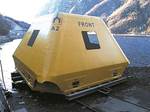Downhole Composites Boost Durability, Drillability
Halliburton Energy Services, Schlumberger Oilfield Services, Weatherford International, and Baker Oil Tools, all based in Houston, Texas (U.S.A.), offer composite downhole tools — made with both thermoplastics and thermoset resins — for a variety of applications. Halliburton’s FasDrill packers and plugs
Halliburton Energy Services, Schlumberger Oilfield Services, Weatherford International, and Baker Oil Tools, all based in Houston, Texas (U.S.A.), offer composite downhole tools — made with both thermoplastics and thermoset resins — for a variety of applications.
Halliburton’s FasDrill packers and plugs have been available since the mid-1980s. “Composite downhole products offer incredible drillability performance, saving the customer hours in rig time and rig cost, particularly offshore where rig rates can be $250,000 per day,” says Halliburton’s Chris Zimmerman.
Baker’s composite expendable tools, such as drillable liner wiper plugs and landing collars, have been used in liner cementing operations, since 1998. Aluminum or other soft metal is the traditional material for these parts, but once the liner has been placed, the collar and wiper plugs must be drilled out. Drilling through metal is a slow process and can lead to excessive vibration in the liner.
Baker’s composite parts are manufactured by filament winding, table rolling and resin transfer molding, using a combination of glass and carbon fiber reinforcement and epoxy resin. The wiper plug incorporates a filament wound glass/epoxy core, a carbon fiber/epoxy “nose,” and circular rubber fins that are molded onto the composite, says Baker’s Jim Goodson.
Weatherford has manufactured a composite bridge plug — a device for isolating a production zone — by filament winding, using glass and high-temperature epoxy resin. Designed for 4.5 inch/11 cm casing, the plug can hold an 8,000 psi/550 bar pressure differential, withstand 250°F/120°C for at least one week and has a drill-up time of less than 30 minutes. According to Bob Badrak, Weatherford’s manager of engineering materials, the fast drill-up and lower density of the material means it can be drilled using a coiled tubing rig, at less cost. Badrak says that more than 100 bridge plugs and frac plugs for 4.5 inch/11 cm casing are currently in service.
Related Content
-
Plant tour: Albany Engineered Composites, Rochester, N.H., U.S.
Efficient, high-quality, well-controlled composites manufacturing at volume is the mantra for this 3D weaving specialist.
-
JCB Aero aircraft interior flooring panels incorporate SHD composites
High-performance carbon fiber prepreg using SHD’s FRVC411 epoxy resin system resulted in a durable, compliant design for the MRO market.
-
Bio-based epoxy, recycled materials increase sustainability of all-terrain snowboards
Aiming for a smaller environmental footprint while maintaining high performance, Salomon’s Highpath snowboard line incorporates bio-based epoxy, glass and basalt fiber stringers and recycled materials.















